Whether you're an experienced traveller or just want to make the most of the space available in your rucksack, knowing how to pack a backpack for travel can save you a lot of time and hassle.
How to pack a backpack for travel
Published 2 years ago

Packing well can make or break a trip – it's the difference between you having everything you need and the headache of missing items, or packing too much and facing the uncomfortable experience of lugging around bags that are far too heavy.
Clever packing is also a factor in keeping your valuables safe and being able to find anything you need quickly and easily. And if you pack a backpack well, you should be able to carry it comfortably on your back for extended periods.
So whether you're travelling abroad or having a break closer to home, here's our ultimate guide to packing everything you need for your trip in a backpack.
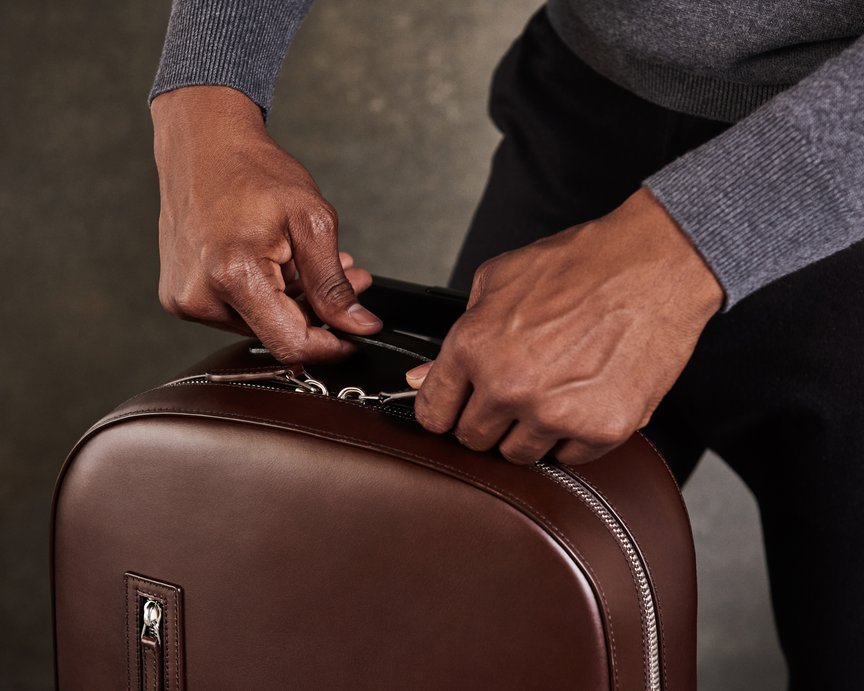
Packing a backpack for a short trip
If you're only travelling for a few days, packing a backpack for travel becomes slightly easier, although you'll still have to be disciplined with yourself to avoid taking too much. Packing is something you should consider carefully and take time to get right.
Make sure you have a healthy amount of floor space around you when packing, or a bed to place your clothing and other items on. Lay out all of the items you are considering taking, including:
- Shirts
- Trousers
- Underwear
- Shoes
- Accessories
- Toiletries
- First aid
- Electronics
- Gadgets
At this stage, you should have a huge pile of worldly goods in front of you. You need to identify which items from this large pile you actually need to take, rather than want to take. So for important things like passports, electronics, money and credit cards, first aid and health items, you'll need to put these to one side, as you'll definitely need them.
Prioritise which items you need to take
For the remainder of the items left on the pile, it's time to focus on what you really need to take with you. For instance, if you're only going for a short trip, consider travelling in shoes you can wear for the duration of your trip.
If this isn't doable, limit yourself to just one other pair of shoes. Luxury items that aren’t essential to your trip should be removed from the pile. If there's any room left as you pack, you can always introduce them back.
Choose versatile clothing
As far as clothing goes, you should be able to fit around 3-5 days worth of clothing in an average backpack with a stringent approach. If you're doing multiple types of activity on your trip, try to keep clothing as versatile as possible. For instance, take trousers that you can dress up or down, or a shirt that you can go from day to night without needing to change.
If you already have backpacking experience, you'll know the rule that less is more and that many items you plan on taking end up being removed from your packing list. If you’re just packing for a weekend trip, you can add a little more variety to your clothes as you’ll have more space.

How to order items in your backpack
The order you pack items in your backpack can impact the comfort of carrying the bag and the ease of being able to get things out when you need them. If you’re going to be carrying your bag around all day, and on and off a flight, you’ll need to make sure the weight is evenly distributed and you can access everything you need.
Consider the below tips when packing your items:
- Bottom of the bag: midweight items. This can include clothes and accessories that you won’t need access to until you reach your destination
- Middle of the bag: heaviest items. Things like shoes, electronics and toiletries; having these items in the middle helps distribute the most weight to the centre of your back
-
Top of the bag: small items you need quick access to. This is where you’ll keep your important documents, passport, wallet and anything else you’ll want to be able to grab quickly. If you have an internal pocket in your backpack, these items can also be stored here
- Side pockets: other small items. If your bag has extra pockets on the outside, consider using these to store things like snacks, small toiletries and any other small miscellaneous items
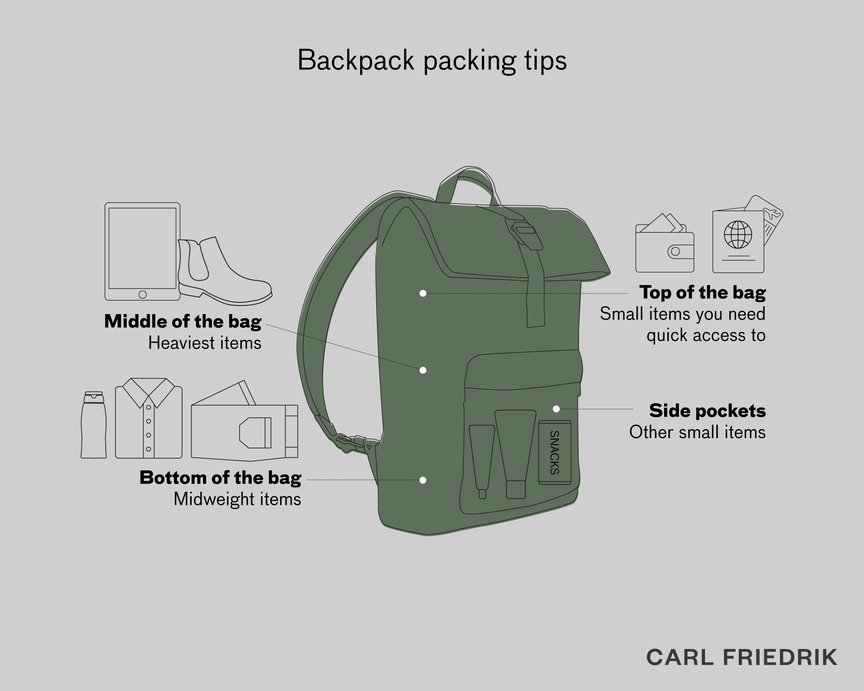
How to pack toiletries in a backpack
Of course, even if you're travelling with just a backpack, you'll need some must-have toiletries for your trip. Bottles can really take up a lot of room (not to mention weight), so efficient packing is important. Like the approach you took when packing your clothing, start by making a checklist of all the toiletries you'll need for your trip, and that you think you'll use.
Choose essentials over luxuries
This typically includes:
- Shower gel
- Shampoo
- Conditioner
- Deodorant
- Toothbrush
- Toothpaste
- Razor
- Cleanser
- Moisturiser
- Sunscreen
- Hair brush or comb
- Contact lenses if you use them
Getting mini travel versions of these products is a great way to save space in your backpack and ensure you can fit everything you need for your trip. This can, however, prove expensive if you're buying small versions of everything, so another option is to buy reusable travel bottles and fill them up with your usual toiletries.
Keep toiletries neat and prevent spills
Place your toiletries in resealable bags to stop them from leaking and spilling onto your packed clothing. If you can, purchase a compact toiletry bag that has multiple compartments to store bottles and smaller items like plasters and painkillers.
Products like soap and shampoo bars can be packed flat, and don't count as liquids, so if you're flying for a trip, consider solid toiletries to help you comply with travel regulations. Carry extra resealable bags as a precaution for anything that could leak and to carry dirty items like a wet washcloth or used swimwear.
When packing your toiletry bag, place the items you use less at the bottom and items you use more frequently at the top. If when you zip it up, you can't get it closed easily, you're putting too much pressure on the zip, and you should think about removing a product or two.

How to pack clothes in a backpack
The secret to packing clothes in a backpack is to roll them up rather than fold them. Once you've decided which clothing you're actually taking on your trip, it's time to roll up as many clothing items as you can (even your socks and underwear to save on space).
For bigger items like T-shirts, fold in the arms to make a rectangle, then fold the T-shirt in half, and then half again to make a long, thin rectangle. Next, roll it up and you'll be able to place it in your backpack while saving a lot of space. For items like socks, these can be fitted into shoes (if you're packing them) for maximum efficiency.
Some people worry about creasing when folding up clothing. By rolling your clothing to pack it in a backpack, you're just reshaping the material — you're not compressing or squashing it. The aim is to push unneeded air out of your clothing so that it fits more tightly into your bag.
You're controlling the amount of space taken up by rolling rather than folding. You want every inch of space in your backpack to be effectively used. This is why having a flexible, ergonomic and light backpack is also important, as it will stretch and shape to the items you pack in it.
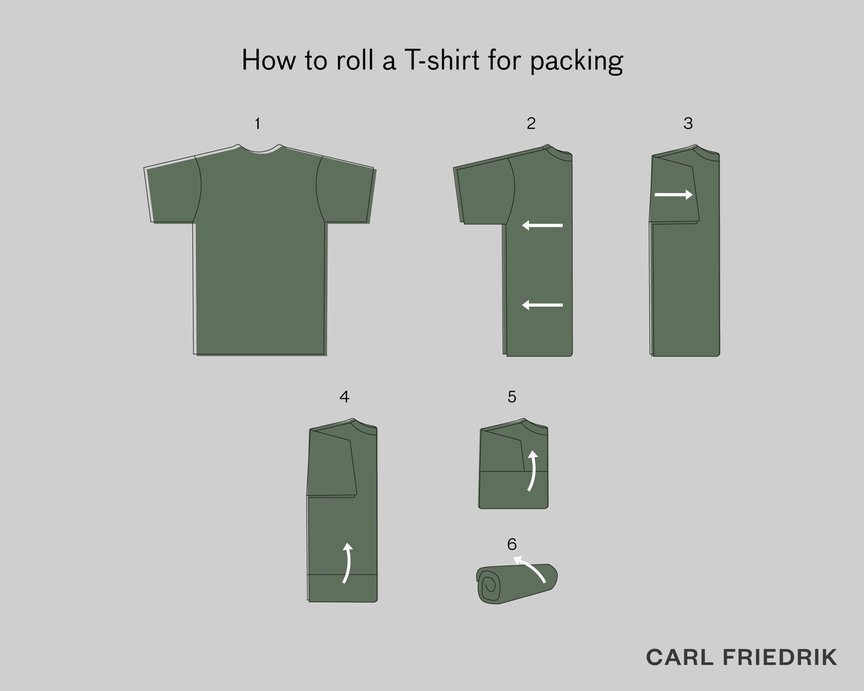
Pack a laundry bag
If you're only travelling with a backpack, take a fabric, waterproof-lined laundry bag with you for dirty items. A packing cube is also a useful investment for the same purpose, but a laundry bag that's made of fabric can be washed in the same way as your dirty clothing.
This bag will help you to easily organize your clean clothes from your dirty ones, and keep everything together so you don't have to keep unpacking and then repacking your rucksack when you need fresh clothes.
Travelling with a backpack and carry-on
Many airlines only allow for one carry-on suitcase and one personal item per person, and the weight and size restrictions can greatly vary for each airline. If you’re travelling with hand luggage only and want to try a two-bag packing approach, here's how you can pack light and make the most of the available space you have.
There are many benefits to having a backpack and a carry-on suitcase, which include increased space and organization, the ability to have all in-flight essentials at your fingertips, having a second bag for personal and daytime use (when you reach your destination) and no checked bag fees.
Be aware of airline rules for each of your bags
Remember that your bags will have two different sets of rules: one for your carry-on and one for your personal item/backpack. Some items that are okay for your carry-on may not be suitable for your personal item. If your carry-on is acting as your main luggage piece, think about packing laptops, electronics and any other large items like shoes and things you don’t need easy access to in there.
In your backpack, pack a change of clothing and underwear (if for any reason your carry-on needs to go in the hold of the plane and you end up separated from it), and your must-have items like passports/documents, keys, wallet and a couple of travel-sized toiletries.
All of your main clothing items and toiletries can go into your carry-on, although you'll need to observe the 100ml rule where it's adopted, depending on where you're travelling to and from. Many airlines will not let you pack larger bottles in your hand luggage, so check with your carrier before travelling.
Using packing cubes in a backpack
Using packing cubes is a great way to keep your backpack organized. It's important to select the right size of packing cube for the job, so make sure to measure your backpack correctly and keep in mind its dimensions when buying your packing cubes.
You'll also need to think about what you're packing in your cubes. It's best to get a mixture of different-sized cubes, so larger items like jeans, jumpers, and shoes can go in bigger cubes, and smaller items like socks, underwear and jewellery can go in the smaller cubes.
How to organise packing cubes in your backpack
When using your packing cubes, group similar items together such as tops, bottoms, underwear and accessories. This will help you determine how many cubes you need and the size you need for each type of item. Next, roll or fold your clothing, and put it into the cubes. Make sure you categorise each cube, so you know which one contains all of your socks, all of your tops, bottoms, etc.
As we discussed earlier, rolling your clothes helps save room and makes organising easier. Make sure to utilise the cube's corners to maximise space. If you can fit a pair of socks in there, do so. Once each cube is packed and filled up, zip it up and compress it by pushing down on it before placing it into your backpack.
Place the bigger packing cubes at the bottom of your backpack, closer to your back, so the weight is better distributed and puts less pressure on your body when you lift or wear the bag.

Best backpacks for travel
The backpack you choose can affect how much you’re able to bring on your trip, and whether you’ll be able to carry everything comfortably. Not to mention how stylish you’ll look out on the open road. Check out some of the backpacks we recommend for travel.
City-hopper Backpack
For daily use or short trips, City-hopper Backpack combines style and functionality with plenty of pockets and compartments to keep your items organised. It’s made to travel with maximum comfort shoulder straps and an integrated luggage holder that fits neatly onto your carry-on suitcase.
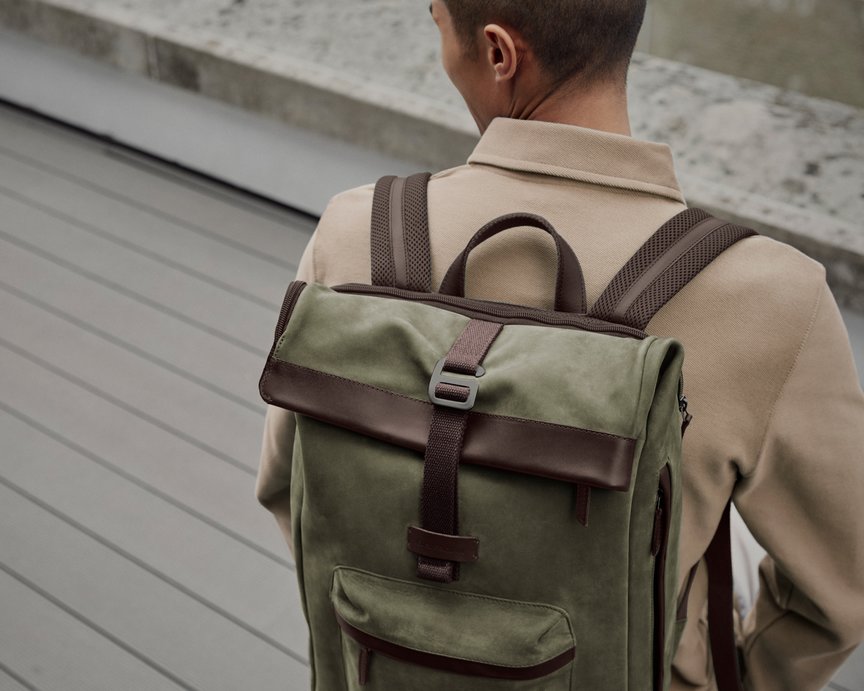
Day-to-Day Backpack
With a foldable design that expands to the size you need, Day-to-Day backpack is versatile enough for the daily commute as well as air travel. Just like the City-hopper Backpack, this bag also features a number of compartments, with a handy luggage holder that contains a zip pocket to store your passport or small valuables.
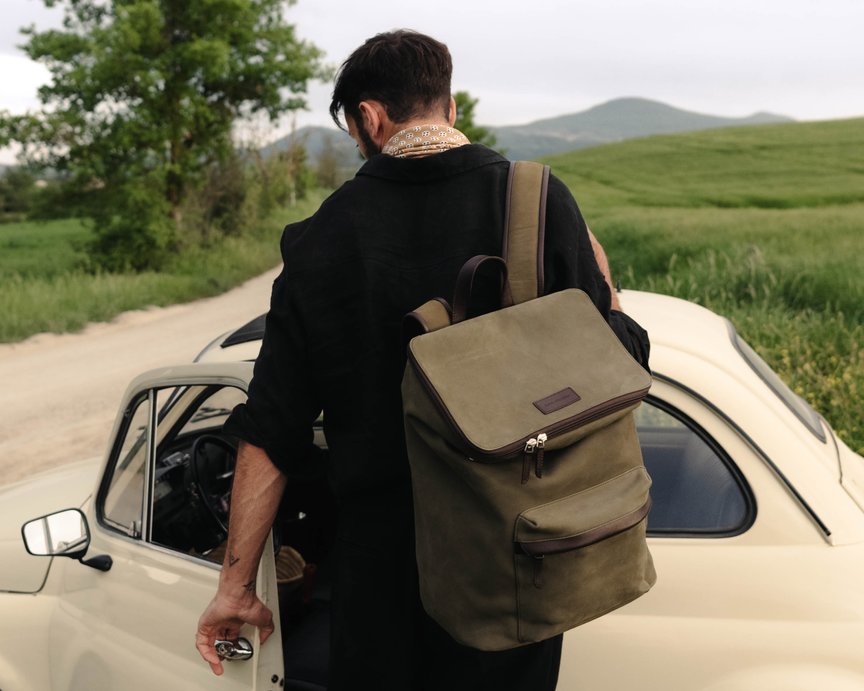
Bowen
The elegant Bowen comes in a choice of refined colours with a sleek design to complement any business or casual outfit. This bag also features comfortable straps, a luggage holder and a padded section to store a laptop.

Takeaway
Being able to efficiently pack a backpack for travel is a great skill to have if you’re on the go a lot. Try out some of the tips in this guide for a stress-free packing experience on your next short trip.